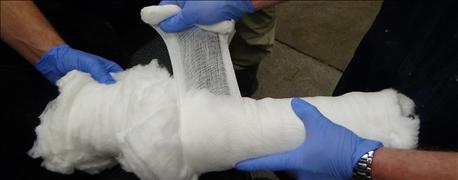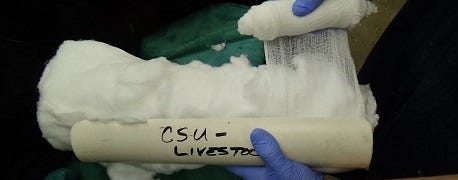May 18, 2016

When calves suffer fractured limbs, they should be cast or splinted quickly for proper healing, even before the veterinarian arrives.
The most common accidents include cows stepping on a newborn calf, legs fractured by improper assistance during birth, or trampling of young calves when cattle are harassed by dogs, coyotes or wolves. Older calves may fracture a leg in a branding or transport accident.
Robert Callan, Colorado State University, says he sees largely-avoidable limb fractures in young calves each year from calving-dystocia incidents.

Quick fix: You can stabilize a broken leg with a Robert Jones bandage. The base is roll cotton wrapped with gauze strip.
“These can happen when calving chains or straps are placed as a single loop around the foot," he says. "We recommend a double loop, with one loop above the fetlock and a half hitch below the fetlock. This spreads pressure so it isn’t all on one area. We see more fractures when mechanical assistance is used to pull the calf.”
Callan says another way legs get fractured during birth is when the calf is upside down or sideways and the person pulling the calf puts too much pressure on the legs to rotate the calf into correct position. The common method is to twist the legs around each other to rotate the calf, but twisting can cause one or both legs to fracture, and those breaks are higher up the leg (mid-cannon) rather than down by the fetlock joint.
He adds that hind legs can be fractured on a backward calf if someone pulls downward on them too forcefully before the hindquarters are out of the cow.
Treat it, pronto
Regardless of the cause of injury, the first thing to do is try to stabilize the bones so no further damage occurs.

Finishing touch: The second and final stage of a Robert Jones bandage on a broken leg is to wrap the roll cotton and gauze bandage with stretchy Vet-Wrap material over the top.
“We need to assess the fracture and identify where it is—whether high or low on the leg. Fractures on the lower leg are easier to deal with than a break above the knee or hock,” Callan says.
“Also, carefully check the leg for any bruising, open wounds, bones sticking out through the skin, or blood at the area of fracture. If there’s any opening in the skin, or bone sticking out, this greatly increases risk for bone infection, and healing may be less successful. If you see any damage to the skin, put the calf on an antibiotic, along with stabilizing the fracture,” he says.
A bandage wrap or splint can be used. There are two methods to support the leg until a veterinarian can assess it. One is a Robert Jones bandage. This consists of a thick layer of cotton padding over the leg, then wrapping tightly over it with gauze and Vetwrap or similar bandaging material. You can buy roll cotton and bandaging material very inexpensively.
Callan says simply wrap the roll cotton around the leg, from the foot up to the joint above the fracture.

Splint beginnings: A splint made with PVC pipe starts with thinner roll cotton for padding and wrap of gauze to hold it in place, either on the front or back of the broken calf leg.
“If it’s a fracture just above the fetlock, apply the cotton wrap up past the knee or hock,” he says. "Apply two to four layers of cotton around the leg, so it’s thick with plenty of padding. Then tightly wrap over the cotton with roll gauze, followed by Vet-Wrap to compress the cotton bandage and hold it in place. This needs to be wrapped tightly, and the outside of the bandage should feel firm and solid. This will help stabilize the fracture until the calf can be examined by your veterinarian."
If there’s any chance the bandage might get wet, use duct tape around the outside, or put a rectal sleeve over the leg to keep the bandage dry. The idea is to provide protection until a more permanent splint or a cast can be applied.
Another option is to make a splint, Callan offers. “The splint can provide support and stabilization for a longer period of time, which is important if it might be several days before the calf can be seen by a veterinarian.”
PVC pipe splints
To make a calf splint with PVC pipe, start with a pipe two to three inches in diameter, depending on the size of the calf's leg.
Next, cut the pipe to length to it is long enough to go from the ground, at the heel of the foot, up to a couple inches above the knee (hock). says Rob Callan, Colorado State University veterinarian.
The splint for a hind leg needs to bend a little at the hock, he says. You can heat the PVC pipe with a cutting torch so it will bend at the proper angle. Use a file or rasp to round off the edges of top and bottom, so it won’t cut into the leg.
"Some people cover the ends of the splint with cotton, taping it on for padding,” Callan says.
Before applying the PVC splint, wrap the leg with roll cotton to provide padding between the leg and splint.
“You don’t need as thick a layer of roll cotton as you would for a Robert Jones bandage,” says Callan, "just enough to provide some padding under the splint so it doesn’t put pressure on the leg. What works really well is to split the thickness of the roll cotton, which is in layers. If you use what would be about one-third thickness, it is really easy to wrap around the leg, rather than use full thickness. Start at the bottom and wrap around and up the leg."
Callan says you want to end up with a layer of about one half to one inch of padding evenly covering the leg. Then place the splint on the back of the leg from the heel to above the knee or hock. Or, you can place the splint on the front of the leg from the toe to just above knee or hock.
The padding underneath the PVC should fit snugly—not too loose nor tight.
After applying the splint over the padding, wrap it tightly with roll gauze, then apply Vet-Wrap over the gauze. This will hold the PVC firmly in place and stabilize the leg.
“You can put sticky elastic tape at the very top and bottom, to keep dirt/straw/hay from getting under the splint,” Callan adds.
Calves grow very fast, so make sure the splint doesn’t become too tight. Split PVC pipe has some give because it is split, and not a complete circle around the leg.
“Check the leg and reset the splint in three to four weeks," Callan says. "Leave it on for a total of at least four to six weeks for a young calf. Don’t take a splint or cast off too early or the calf might re-fracture the leg.”
Vet casts require care
Despite your work stabilizing calves' broken legs, your veterinarian may choose to apply a fiberglass cast.
After the cast is on, make sure it doesn’t get too wet, says Robert Callan, Colorado State University veterinarian. "An easy way to waterproof a splint or cast is to apply silicone, using a silicone gun to smear the whole surface. This creates a tough, waterproof barrier to protect the cast or splint.”
When the cast is removed, clean it and save it for possible later use as a splint for another calf with a fractured leg -- if that calf is about the same size.
To re-use it later, just place roll cotton padding over the leg, put both pieces of the cast over the cotton, and wrap the two pieces of cast together with strong elastic tape, Callan says.
You May Also Like




